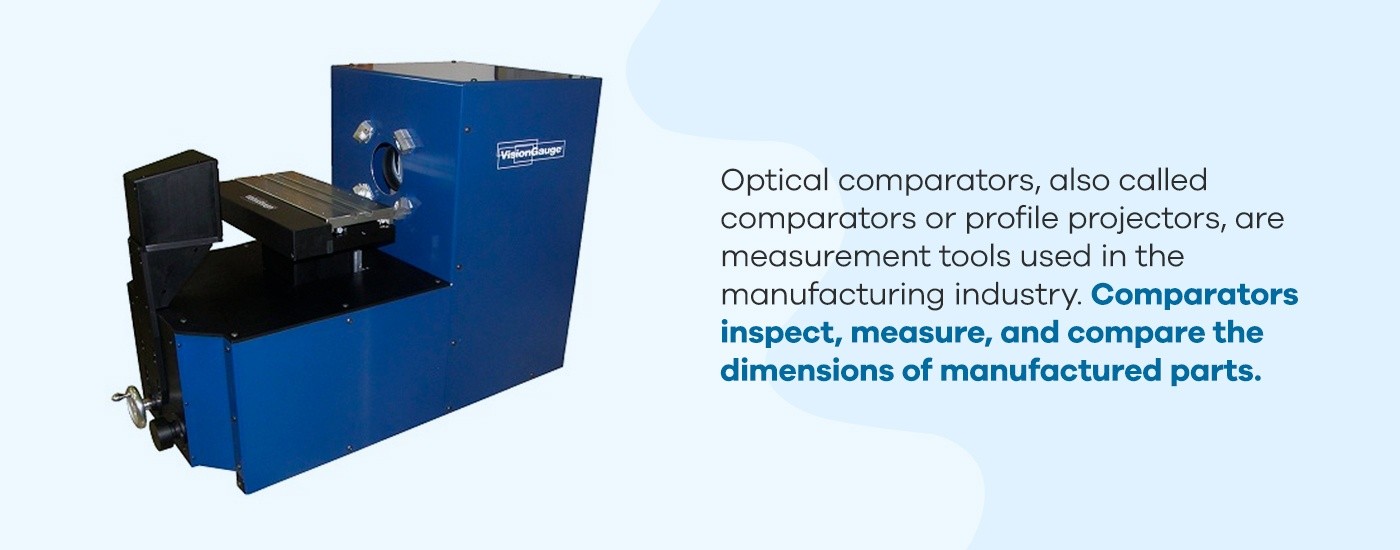A comparator, also known as an optical comparator or profile projector, is a crucial measurement tool used in manufacturing for quality control. It allows for precise inspection and measurement of manufactured parts by projecting a magnified silhouette onto a screen for comparison against a reference standard. This article explores the functionality of a comparator, its applications, and the evolution from traditional to digital models.
How Does a Comparator Work?
A comparator operates on the principles of optics. A light source illuminates the part being inspected, casting a shadow. This shadow is then magnified using a series of lenses and mirrors, and projected onto a screen at a fixed distance. The magnified silhouette allows for detailed examination and measurement of the part’s dimensions and surface features.
Comparators come in two main configurations:
- Horizontal Comparators: The light path is horizontal, ideal for inspecting parts fixed in position, like screws or castings.
- Vertical Comparators: The light path is vertical, best suited for flat components like gaskets or flexible parts that need to lie flat for accurate measurement.
Traditional vs. Digital Comparators: Measurement Methods
Traditional comparators primarily employ two measurement methods:
- Silhouette Measurement: Direct comparison of the projected silhouette to a known scale or grid on the screen.
- Point Comparison: Comparing specific points on the part’s silhouette to corresponding points on a reference overlay.
Digital comparators, however, leverage advanced technology:
- Software Analysis: Utilizing software and digital cameras to capture and analyze the projected image, enabling automated measurements and more complex analyses. This includes direct comparison to CAD drawings.
Limitations of Traditional Comparators
While simple to operate, traditional comparators have limitations:
- Limited Complexity: Challenging to inspect complex parts requiring multiple viewing angles.
- Lower Accuracy: Manual measurements are susceptible to human error and may not meet the stringent tolerances of modern parts.
- Labor Intensive: Inspecting large quantities of parts is time-consuming.
- 2D Limitations: Inability to analyze three-dimensional features.
Advantages of Digital Comparators
Digital comparators address the shortcomings of traditional models:
- Automation: Automated measurement processes significantly increase speed and throughput.
- 3D Capabilities: Advanced lighting techniques and software enable three-dimensional inspection.
- Higher Accuracy: Eliminating human error ensures precise measurements.
- Data Analysis: Provides quantifiable data for detailed reporting and analysis.
Applications of Digital Comparators
Digital comparators find applications in diverse industries:
- Quality control in manufacturing
- Inspection of complex parts
- Reverse engineering
- Measurement of intricate geometries
Conclusion: The Future of Comparator Measurement
Comparator measuring instruments have evolved significantly since their inception. While traditional comparators still hold value for specific applications, digital comparators offer significant advantages in terms of speed, accuracy, and capability. The ability to automate measurements, perform 3D inspections, and generate detailed data analysis makes digital comparators essential tools for modern manufacturing and quality control. They ensure that increasingly complex parts meet the demanding tolerances required in today’s industries.


